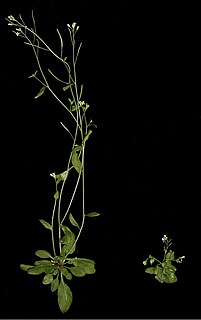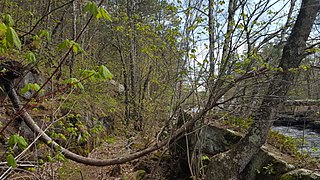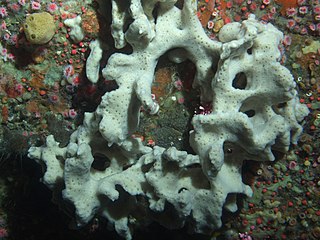
The vascular cambium is the main growth tissue in the stems and roots of many plants, specifically in dicots such as buttercups and oak trees, gymnosperms such as pine trees, as well as in certain vascular plants. It produces secondary xylem inwards, towards the pith, and secondary phloem outwards, towards the bark. In herbaceous plants, it occurs in the vascular bundles which are often arranged like beads on a necklace forming an interrupted ring inside the stem. In woody plants, it forms a cylinder of unspecialized meristem cells, as a continuous ring from which the new tissues are grown. Unlike the xylem and phloem, it does not transport water, minerals or food through the plant. Other names for the vascular cambium are the main cambium, wood cambium, or bifacial cambium.

Plant hormones are signal molecules produced within plants, that occur in extremely low concentrations. Plant hormones control all aspects of growth and development, from embryogenesis, the regulation of organ size, pathogen defense, stress tolerance and through to reproductive development. Unlike in animals each plant cell is capable of producing hormones. The term 'phytohormone' was coined by Went and Thimann and used in the title of their book in 1937.

Auxins are a class of plant hormones with some morphogen-like characteristics. Auxins play a cardinal role in coordination of many growth and behavioral processes in plant life cycles and are essential for plant body development. The Dutch biologist Frits Warmolt Went first described auxins and their role in plant growth in the 1920s. Kenneth V. Thimann (1904-1997) became the first to isolate one of these phytohormones and to determine its chemical structure as indole-3-acetic acid (IAA). Went and Thimann co-authored a book on plant hormones, Phytohormones, in 1937.

Cytokinins (CK) are a class of plant growth substances (phytohormones) that promote cell division, or cytokinesis, in plant roots and shoots. They are involved primarily in cell growth and differentiation, but also affect apical dominance, axillary bud growth, and leaf senescence. Folke Skoog discovered their effects using coconut milk in the 1940s at the University of Wisconsin–Madison.

Gravitropism is a coordinated process of differential growth by a plant or fungus in response to gravity pulling on it. Gravity can be either "artificial gravity" or natural gravity. It is a general feature of all higher and many lower plants as well as other organisms. Charles Darwin was one of the first to scientifically document that roots show positive gravitropism and stems show negative gravitropism. That is, roots grow in the direction of gravitational pull and stems grow in the opposite direction. This behavior can be easily demonstrated with any potted plant. When laid onto its side, the growing parts of the stem begin to display negative gravitropism, growing upwards. Hebaverns (non-woody) stems are capable of a small degree of actual bending, but most of the redirected movement occurs as a consequence of root or stem growth outside.

Indole-3-acetic acid is the most common, naturally occurring, plant hormone of the auxin class. It is the best known of the auxins, and has been the subject of extensive studies by plant physiologists. IAA is a derivative of indole, containing a carboxymethyl substituent. It is a colorless solid that is soluble in polar organic solvents.

Indole-3-butyric acid (1H-indole-3-butanoic acid, IBA) is a white to light-yellow crystalline solid, with the molecular formula C12H13NO2. It melts at 125 °C in atmospheric pressure and decomposes before boiling. IBA is a plant hormone in the auxin family and is an ingredient in many commercial horticultural plant rooting products.

The hairpin banksia is a species of woody shrub, of the genus Banksia in the family Proteaceae, native to eastern Australia. Widely distributed, it is found as an understorey plant in open dry forest or heathland from Victoria to northern Queensland, generally on sandstone though sometimes also clay soils. It generally grows as a small shrub to 2 metres (7 ft) in height, though can be a straggly tree to 6 metres (20 ft). It has long narrow leaves with inflorescences which can vary considerably in coloration; while the spikes are gold or less commonly yellowish, the emergent styles may be a wide range of colours – from black, purple, red, orange or yellow.

Banksia spinulosa var. collina is a shrub that grows along the east coast of Australia, in Queensland and New South Wales. Commonly known as Hill Banksia or Golden Candlesticks, it is a taxonomic variety of B. spinulosa. It is a popular garden plant widely sold in nurseries.

Banksia spinulosa var. spinulosa is a shrub that grows along the east coast of Australia, in Queensland and New South Wales.

Psymberin, also known as irciniastatin A, is a cytotoxin derived from sea sponges. It was discovered by two independent research groups in 2004. Psymberin was found to be highly bioactive as it showed LC50s at nanomolar concentrations against various types of tumors.
Ircinia strobilina is a species of sponge in the family Irciniidae. It is grey or shiny black in colour, with spiny structures (conules) dotting the surface. The spiny structures are interconnected by ridges, though not arranged in an orderly lattice. This species is globular and massive in shape, but usually no more than 0.3 metres (1 ft) across. I. strobilina is lobed and spherical and has a tough consistency. The large excurrent pores are located in depressions at the top of the sponge. Many smaller incurrent pores are scattered across the surface, more densely at the sides.

Achaeopsis spinulosa, the hotlips spider crab, is a species of crab in the family Inachidae, found only around the South African coast. It is the only species in the genus Achaeopsis.

Pinitol is a cyclitol, a cyclic polyol. It is a known anti-diabetic agent isolated from Sutherlandia frutescens leaves. Gall plant tannins can be differentiated by their content of pinitol. It was first identified in the sugar pine. It is also found in other plants, such as in the pods of the carob tree.
The black stink sponge, Ircinia arbuscula, is a species of marine demosponge in the family Irciniidae. This sponge is known around the Australian coast and around South Africa from the Cape Peninsula to Cape Agulhas.

Phototropism is the growth of an organism in response to a light stimulus. Phototropism is most often observed in plants, but can also occur in other organisms such as fungi. The cells on the plant that are farthest from the light have a chemical called auxin that reacts when phototropism occurs. This causes the plant to have elongated cells on the farthest side from the light. Phototropism is one of the many plant tropisms or movements which respond to external stimuli. Growth towards a light source is called positive phototropism, while growth away from light is called negative phototropism (skototropism). Most plant shoots exhibit positive phototropism, and rearrange their chloroplasts in the leaves to maximize photosynthetic energy and promote growth. Some vine shoot tips exhibit negative phototropism, which allows them to grow towards dark, solid objects and climb them. The combination of phototropism and gravitropism allow plants to grow in the correct direction.

Polydiscamide B, and related compounds, are sea sponge isolates and human sensory neuron-specific G protein coupled receptor agonists.

Lacking an immune system, protective shell, or mobility, sponges have developed an ability to synthesize a variety of unusual compounds for survival. C-nucleosides isolated from Caribbean Cryptotethya crypta, were the basis for the synthesis of zidovudine (AZT), aciclovir (Cyclovir), cytarabine (Depocyt), and cytarabine derivative gemcitabine (Gemzar).
















